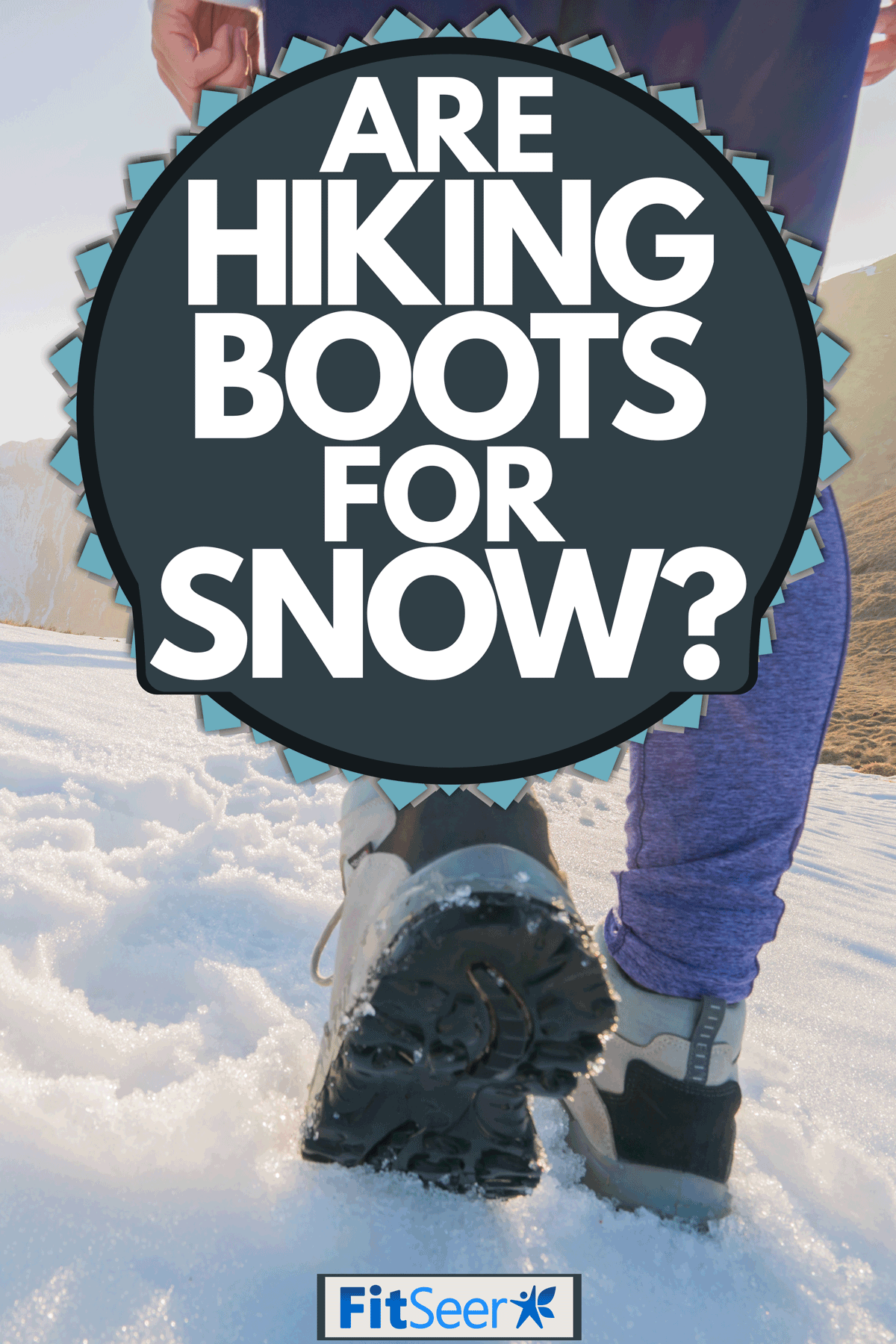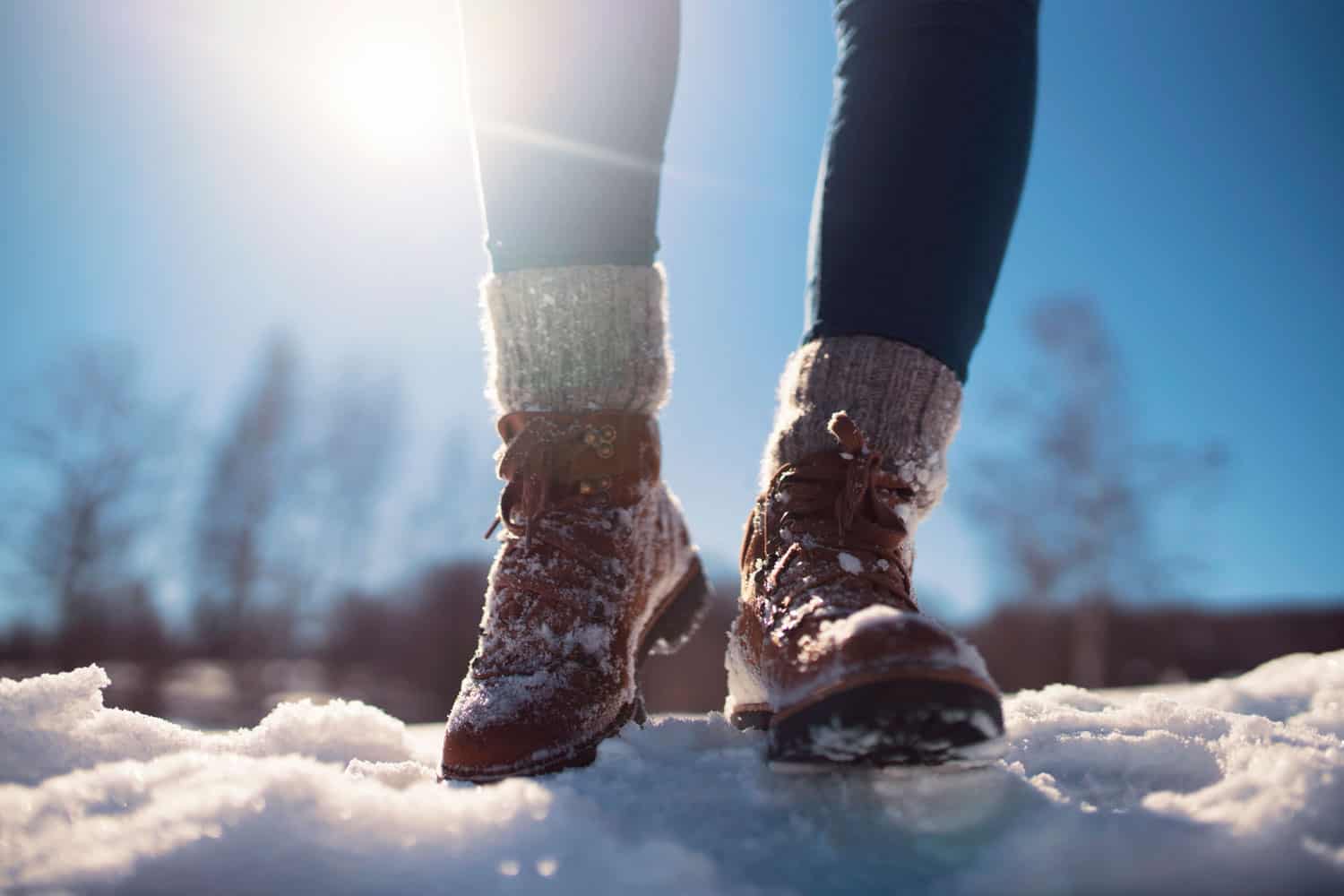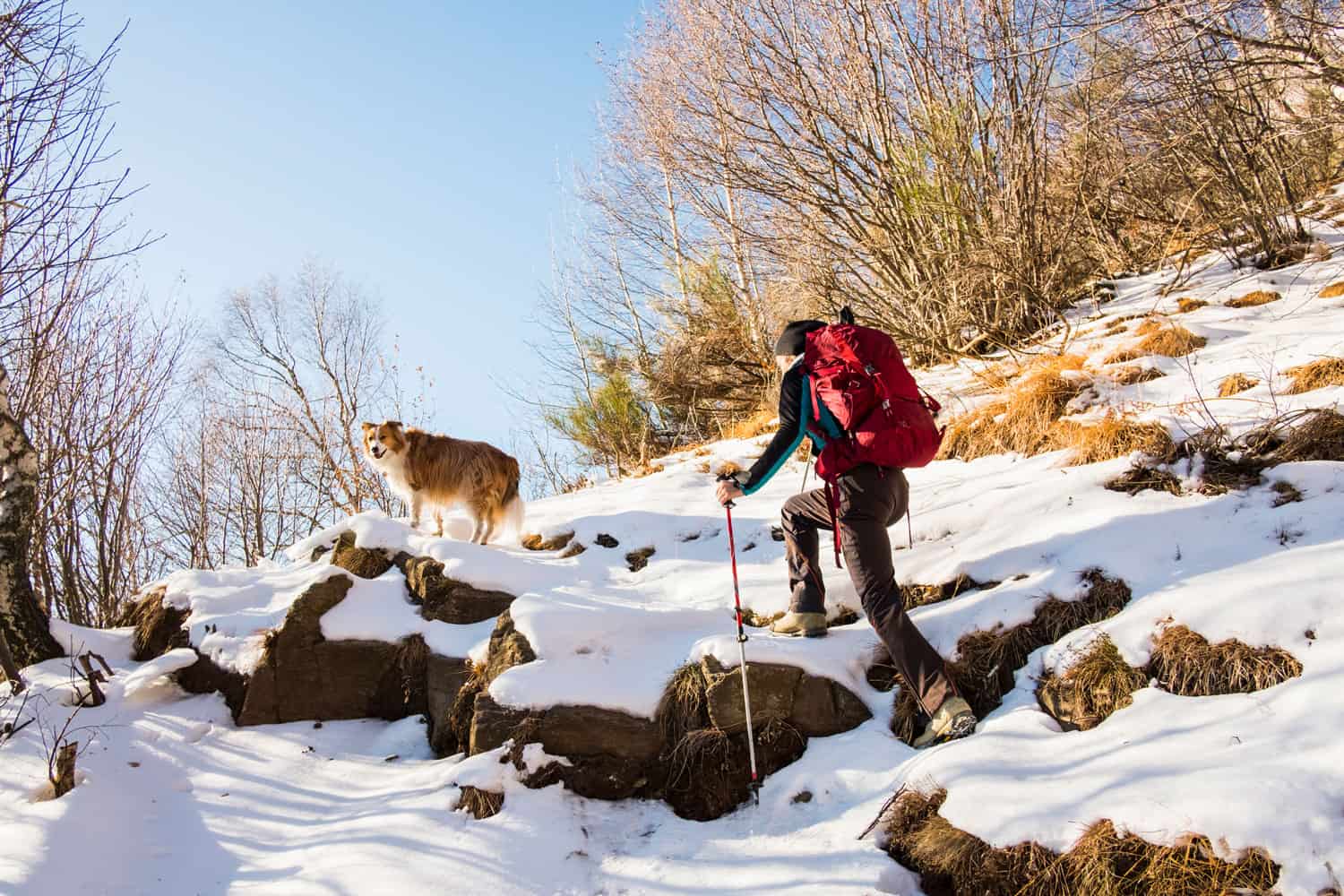Every serious hiker has their favorite pair of hiking boots. But if the hiking itch comes when it's snowy outside, you might be curious about what kind of boots would work best. Should you wear your hiking boots in the snow? We've researched this question and have come up with the answer.
Hiking boots might work in the snow, as long as they're waterproof, are tall enough to keep snow out, and have deep enough traction to keep you steady in the snow. If you're planning on hiking in snowy terrain, consider purchasing a pair of winter boots, which have the traits of both snow boots and hiking boots.
Nobody likes cold, wet feet, so it's important to have the right footwear for the type of weather. That's why we've put together this guide to help you understand the difference between hiking boots and snow boots, how to pick out the right boots, and other ways to make sure your hiking experience is as healthy as possible. Let's trek on!

Are Hiking Boots And Snow Boots The Same?

Hiking boots and snow boots might look similar, but there are several reasons they're designed for a specific purpose. Here is a description of each.
Hiking Boots
Hiking boots are designed for dirt, rock, or other unstable surfaces. They have plenty of support to protect you from injury and offer enough traction to keep you sturdy on a warm-weather hike. However, they combine this sturdiness with a light-weight profile. Since they're designed to be used in warm weather, many versions are breathable to keep your feet cool.
You can find hiking boots in low to mid-ankle height, depending on your preference. Because they don't go as high up the leg as many snow boots, you're at risk of snow getting in the top of the shoe. High-end hiking boots tend to be waterproof, which is helpful for snow. But in general, hiking boots won't keep snow out as well as snow boots.
Click here to view these hiking boots on Amazon.
Hiking boots are incredible at keeping you sturdy on uneven surfaces. But are they equipped for all your walking needs? Read this article for more info: Are Hiking Boots Good For Walking On Concrete?
Snow Boots
Snow boots are purposefully designed with heavy snow in mind. They, like hiking boots, offer traction on potentially slick surfaces. However, they're almost completely waterproof, depending on the level of quality. Unlike most hiking boots, which are meant for sunny days of hiking, snow boots usually have a warm liner.
Most snow boots go higher up the leg to make it harder for the snow to get in. In general, snow boots are more concerned with keeping your feet dry and warm than they are with comfort, so they might be painful during a long hike. If you're planning on being in high snow, you'll appreciate snow boots more than hiking boots.
Click here to view these snow boots on Amazon.
Wearing Hiking Boots In The Snow

As we've mentioned, if you're going to be wearing hiking boots in the snow, they should be waterproof, tall enough to keep snow out, and have sufficient traction for snow. Let's look at each attribute a little closer.
Waterproof
Having waterproof hiking boots ensures that your feet won't get soaked as you traipse through the snow. Cold, wet feet is no way to hike in snowy conditions.
Tall Enough To Keep Snow Out
If you're going to be wearing hiking boots in the snow, you'll want the boots to be able to keep out snow. Short hiking boots may not adequately do the job.
Traction
Traction is the third thing to keep in mind when hiking in the snow. Snow can easily become slippery and cause you to lose your balance. Boots with sufficient traction prevent this unfortunate event from occurring.
Winter boots are an exceptional alternative to ordinary hiking boots. They have attributes of both hiking boots and snow boots, making your snowy hiking experience much more enjoyable.
Can You Wear Normal Boots In Snow?
You can wear any type of boot in the snow, but they may not give you the waterproof protection or traction that you need, depending on what kind of snow it is. For instance, a pair of suede boots might be ruined if they get wet. Or, a pair of cowboy boots won't give you enough traction, so you'll need to be careful where you step.
Normal boots might be acceptable if you're walking short distances in small amounts of snow. But if you're walking on slippery surfaces or in deep snow, you'll want a pair of waterproof boots that will keep you warm and safe. If you're going to wear non-waterproof boots in the snow, consider using a waterproofing spray to make sure they don't get ruined. This is perfect for leather, suede, and most other materials.
Click here to view this spray on Amazon.
What Do You Wear Hiking In The Snow?

Boots
So, what should you wear if you need a combination of hiking and snow boots? Look for a "winter boot" that offers comfort, insulation, and waterproof. This type of boots is the best of both worlds, including comfort and stability. Because you're getting two types of boot, expect to pay more than you would for a single-use boot.
These two pairs of Salomon boots are some of the best on the market, rated for use in -40 degree weather! They're comfortable and warm with plenty of traction.
Click here to view these boots on Amazon.
Click here to view these boots on Amazon.
Planning on doing extreme snow hiking? You'll need a hefty pair of boots like these from La Sportiva. They use Gore-Tex to keep your feet warm and dry. They're pricy, so look elsewhere if you just need a pair of winter boots to take you on a mild trail.
Click here to view these boots on Amazon.
Gloves
Few things ruin a hike like frozen fingers. So make sure you're wearing the right gloves. Look for a pair that has a waterproof outer shell and a warm wool or fleece interior.
Click here to view these gloves on Amazon.
Jacket And Coat
When you're exercising in the cold weather, you'll fluctuate between hot and cold. Thus, it's useful to wear at least three layers of outerwear. Try wearing a warm thermal layer on the bottom. This is the base layer, and it will keep you warm, trapping your body heat under your coat.
Click here to view this shirt on Amazon.
The mid-layer adds weight to the layers, helping you retain heat even more. A quarter-zip pullover is a popular type of mid-layer.
Click here to view this pullover on Amazon.
Finally, your top layer should have some waterproofing abilities and be a windbreaker as well. Ski coats are great for any cold-weather activity, so look for one of those.
Click here to view this coat on Amazon.
Gaiter
A gaiter is a piece of cloth that goes around your neck. It traps your heat and can be pulled up over your face to keep the wind off. If you're going to hike in high altitudes, you'll want a way to keep the wind off your sensitive head and neck area. A gaiter is a perfect way to do that and covers areas your hat won't.
Click here to view this gaiter on Amazon.
Hat
Your head is sensitive to cold weather and snow, so you'll want to protect it. Whether you call it a sock cap, beanie, or some other name, you'll want some form of protection. A tight-fitting hat will do the trick.
Click here to view this hat on Amazon.
Click here to view this hat on Amazon.
Pants
Like with your torso, you'll want to layer your pants for cold weather. Use a pair of thermal leggings or underpants as the base layer. These can be form-fitting and made from synthetic material.
Click here to view these pants on Amazon.
Then, put a warm, waterproof layer on top. These will keep you warm while still allowing you to walk comfortably. This pair, for instance, is insulated and waterproof.
Click here to view these pants on Amazon.
Sunglasses
Even if the ground is snowy, the sun might still beat down on you as you hike. Use a pair of sunglasses to keep it out of your eyes. Make sure your shades fit comfortably so they won't be jarred loose. Here are a couple of good options.
Click here to view these sunglasses on Amazon.
Click here to view these sunglasses on Amazon.
Hiking in all types of weather is a fun, potentially relaxing form of exercise. But does it burn as many calories when you're walking downhill? Check out this article for the details: Does Hiking Downhill Burn Calories?
How Can You Make Hiking Boots More Comfortable?
Hiking boots are intended to strike a balance between comfortable and supportive. However, if you find that you need more comfort, here are a few things you can try.
Break Them In
Brand new hiking boots might not feel comfortable immediately. It will take a while before the material stretches out enough to feel comfortable and before they mold to your feet. So, you'll need to break them in!
Wear them for twenty or thirty minutes at a time to start. Walk around your house, yard, or the block until they feel comfortable. Don't immediately wear them out on a long hike unless you want sore feet and blisters. If simply wearing them isn't enough to make them comfortable, aim a blow dryer at them for a couple of minutes before putting them on. This will make the material flexible enough to form to your feet.
Wear The Right Socks
It's amazing how the right socks can quickly help your feet feel better. If you're going to be hiking, look for a pair made out of synthetic material. Though cotton is cheap to produce, it doesn't absorb moisture well. It also isn't as soft as polyester or other synthetic materials, which is important when your feet will be pounding the trail repeatedly.
Here are a few good options for comfortable hiking socks.
Feideer Socks
Click here to view these socks on Amazon.
Innotree Socks
Click here to view these socks on Amazon.
Make Sure They're The Right Type Of Boot
Make sure you have the right type of hiking boot for your purpose. If you're going to hike long distances over relatively even terrain, you'll probably want a lightweight, breathable pair like the ones below. Otherwise, your boots will feel heavy and clunky.
Click here to view these boots on Amazon.
Or, if you're going to do heavy-duty hiking with lots of elevation change, you'll want something more sturdy, like the boots below. A lighter, less technical option will feel unsafe since you don't have enough support.
Click here to view these boots on Amazon.
How Can You Tell If Your Boots Fit Properly?

Hiking boots should fit your feet snugly without being uncomfortable. This is a fine line, especially since your feet grow and shrink depending on the time of day. At the end of the day -- or after exercising for a while -- your feet swell slightly because of the amount of blood. So, figuring out whether or not your boots fit correctly as your feet change size can be tricky.
One way to measure this is to put your foot into the boot, then move your toes to the front of the shoe. You should be able to fit your index finger between your Achilles and the back of the boot. If you can't, the boots are probably too short, which will eventually be painful.
There also shouldn't be any "hot spots" when you put on the boots. These are spots that restrict your feet uncomfortably. Put the boots on and walk around for a few minutes. If you feel any hot spots, they don't fit properly. The hot spots will only get worse as you walk further.
In Closing
In general, hiking boots and snow boots are different based on their ability to keep water out, keep your feet warm, and keep you steady. If your hiking boots do all of these things, they might be considered winter boots. If not, consider buying a pair that will meet all your needs.
We hope this article has helped you figure out what footwear is best for your needs. Here's to safe, exciting hiking -- good luck!

























![Read more about the article Is Surfing Easy or Hard to Learn? [Here Are the 6 Steps to Take]](https://fitseer.com/wp-content/uploads/2020/11/Surfer-on-Blue-Ocean-Wave-in-the-Tube-Getting-Barreled-500x333.jpg)

![Read more about the article How Much Does It Cost to Go Bowling? [and Should You Buy Your Own Gear]](https://fitseer.com/wp-content/uploads/2020/10/Close-up-view-score-monitor-in-bowling-club-500x333.jpg)